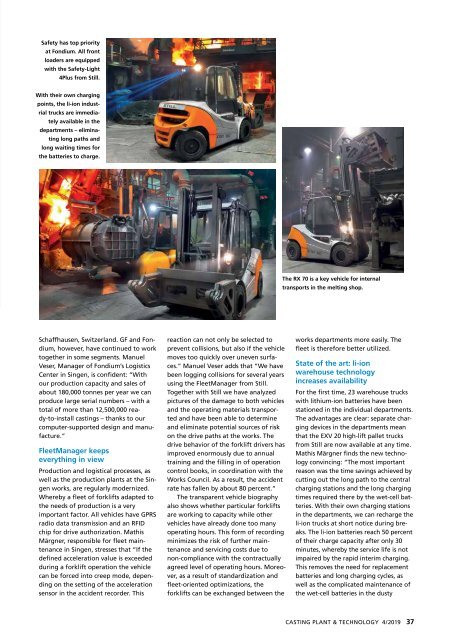CPT International 4/2019
Create successful ePaper yourself
Turn your PDF publications into a flip-book with our unique Google optimized e-Paper software.
Safety has top priority<br />
at Fondium. All front<br />
loaders are equipped<br />
with the Safety-Light<br />
4Plus from Still.<br />
With their own charg ing<br />
points, the li-ion industrial<br />
trucks are immediately<br />
available in the<br />
departments – eliminating<br />
long paths and<br />
long waiting times for<br />
the batteries to charge.<br />
The RX 70 is a key vehicle for internal<br />
transports in the melting shop.<br />
Schaffhausen, Switzerland. GF and Fondium,<br />
however, have continued to work<br />
together in some segments. Manuel<br />
Veser, Manager of Fondium’s Logistics<br />
Center in Singen, is confident: “With<br />
our production capacity and sales of<br />
about 180,000 tonnes per year we can<br />
produce large serial numbers – with a<br />
total of more than 12,500,000 ready-to-install<br />
castings – thanks to our<br />
computer-supported design and manufacture.”<br />
FleetManager keeps<br />
everything in view<br />
Production and logistical processes, as<br />
well as the production plants at the Singen<br />
works, are regularly modernized.<br />
Whereby a fleet of forklifts adapted to<br />
the needs of production is a very<br />
important factor. All vehicles have GPRS<br />
radio data transmission and an RFID<br />
chip for drive authorization. Mathis<br />
Märgner, responsible for fleet maintenance<br />
in Singen, stresses that “If the<br />
defined acceleration value is exceeded<br />
during a forklift operation the vehicle<br />
can be forced into creep mode, depending<br />
on the setting of the acceleration<br />
sensor in the accident recorder. This<br />
reaction can not only be selected to<br />
prevent collisions, but also if the vehicle<br />
moves too quickly over uneven surfaces.”<br />
Manuel Veser adds that “We have<br />
been logging collisions for several years<br />
using the FleetManager from Still.<br />
Together with Still we have analyzed<br />
pictures of the damage to both vehicles<br />
and the operating materials transported<br />
and have been able to determine<br />
and eliminate potential sources of risk<br />
on the drive paths at the works. The<br />
drive behavior of the forklift drivers has<br />
improved enormously due to annual<br />
training and the filling in of operation<br />
control books, in coordination with the<br />
Works Council. As a result, the accident<br />
rate has fallen by about 80 percent.”<br />
The transparent vehicle biography<br />
also shows whether particular forklifts<br />
are working to capacity while other<br />
vehicles have already done too many<br />
operating hours. This form of recording<br />
minimizes the risk of further maintenance<br />
and servicing costs due to<br />
non-compliance with the contractually<br />
agreed level of operating hours. Moreover,<br />
as a result of standardization and<br />
fleet-oriented optimizations, the<br />
forklifts can be exchanged between the<br />
works departments more easily. The<br />
fleet is therefore better utilized.<br />
State of the art: li-ion<br />
warehouse technology<br />
increases availability<br />
For the first time, 23 warehouse trucks<br />
with lithium-ion batteries have been<br />
stationed in the individual departments.<br />
The advantages are clear: separate charging<br />
devices in the departments mean<br />
that the EXV 20 high-lift pallet trucks<br />
from Still are now available at any time.<br />
Mathis Märgner finds the new technology<br />
convincing: “The most important<br />
reason was the time savings achieved by<br />
cutting out the long path to the central<br />
charging stations and the long charging<br />
times required there by the wet-cell batteries.<br />
With their own charging stations<br />
in the departments, we can recharge the<br />
li-ion trucks at short notice during breaks.<br />
The li-ion batteries reach 50 percent<br />
of their charge capacity after only 30<br />
minutes, whereby the service life is not<br />
impaired by the rapid interim charging.<br />
This removes the need for replacement<br />
batteries and long charging cycles, as<br />
well as the complicated maintenance of<br />
the wet-cell batteries in the dusty<br />
CASTING PLANT & TECHNOLOGY 4/<strong>2019</strong> 37

















